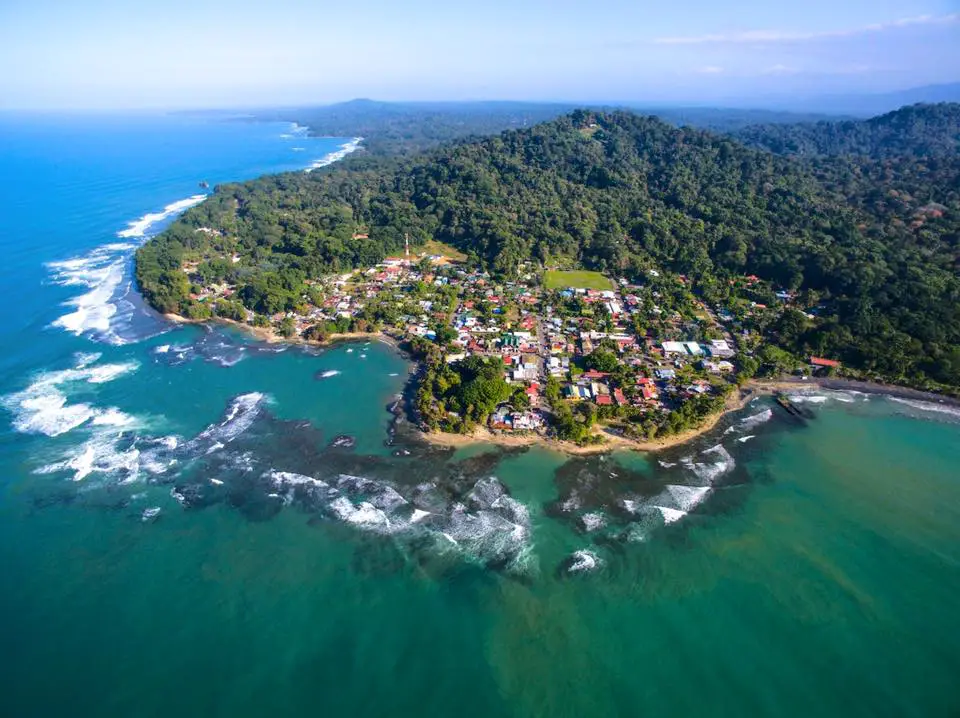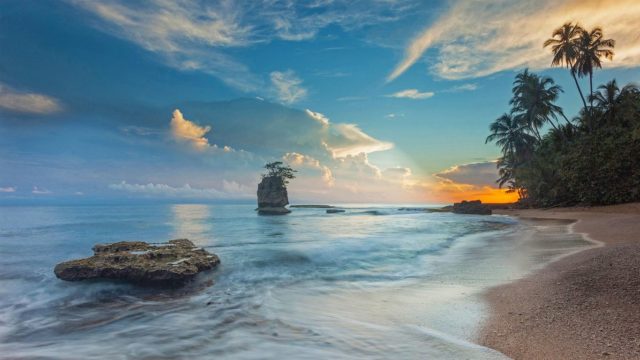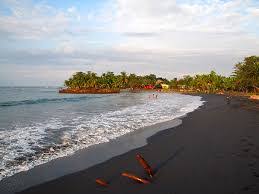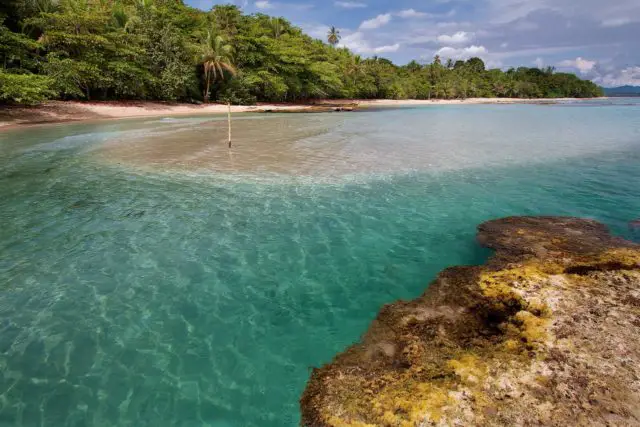On the shores of the Caribbean Sea, Puerto Viejo de Talamanca is a paradise for beach lovers. Located on the Atlantic Ocean in the province of Limón, with exotic flora and fauna, this coastal town with wonderful beaches of crystal clear blue water has quickly become one of the hot tourist spots in Costa Rica. Many surfers from all over the world come for the famous “Salsa Brava” waves.

History.
The town was originally known as “Old Harbor” until the Government of Costa Rica instituted Spanish as the new local language and changed the names of the towns and places in the area from English to Spanish, and the Afro-Caribbean English-speaking culture was actively dismantled. There is another city called Puerto Viejo in northeastern Costa Rica, which can generate some confusion. Buses leave from San José to both places, showing the same destination: “Puerto Viejo”.
Puerto Viejo de Talamanca is a popular tourist destination. It is known in the surf community for having the biggest and most powerful waves in Costa Rica, called “Salsa Brava”. It is also a site of beautiful beaches, such as Playa Chiquita, Playa Negra, and Punta Uva, which are some of the most spectacular beaches in Costa Rica, which can be found between Puerto Viejo and Manzanillo. The latter is a popular place for boating and is located 13 km south, following the beach. The popular “Jaguar” Wildlife Rescue Center is nearby too.
Many tourists stop in Puerto Viejo on their route to the border with Panama, in Sixaola. This border is popular with people coming or going from Bocas Del Toro. Puerto Viejo offers the closest lodging, restaurants, and services to the border. The small border towns of Sixaola and Gabito are located 49 km south of Puerto Viejo and do not offer accommodation or restaurants. Tourists must pass through both Costa Rican and Panamanian customs. Chinguinosa, in Panama, offers lodging, restaurants, and services across the border.
The inhabitants of the town are mostly of Costa Rican origin, with a substantial population of Jamaican descent, as well as a good number of Europeans who have migrated to the region. The surroundings of the city and the mountains of the region are home to the Bividi Native Tribe.
Demolitions (2012-2014).
At the beginning of April 2012, nine business premises and residents were formally notified of impending eviction and subsequent demolition of their properties, for violating the Maritime Land Zone Law. Sixty-six properties (businesses and residences) were declared “in violation” of the Law, and the first phase of the demolitions was planned for November 2012. The reason why the Government decided to act so urgently and decidedly was unknown, but residents allude to the proposals of a mega marina and other development plans for the region. A complex history of laws and decisions were actively reviewed and debated by the affected communities. Finally, in March 2014, the Government decided to reverse and sign a law, previously approved by the Legislative Assembly, to allow residents to stay in their homes and businesses.
The charm of Puerto Viejo.
Simply known as Puerto Viejo by the locals and not to be confused with Puerto Viejo de Sarapiqui in Heredia, this bustling town is 34 miles southeast of Puerto Limón, and 10.2 miles south of Acuita. With its relaxed atmosphere and its unique blend of Latin, Afro-Caribbean and Bividí indigenous cultures.
Puerto Viejo is a lively place to spend a fun and relaxing holiday. This place has a wide variety of bars, clubs, and restaurants, as well as hotels and accommodation at reasonable prices scattered throughout. Also, there are many shopping and general trading opportunities available.
Beaches of Puerto Viejo.
With its golden sand beaches, tropical vegetation and many interesting attractions nearby, such as the Caquita National Park, the Talamanca Indigenous Reserve, and the Guandoca Manzanillo Wildlife Refuge, visiting Puerto Viejo de Talamanca is a great opportunity to experience the best of the Costa Rican coast.
Famous for its fabulous beaches, the Salsa Brava beach in Puerto Viejo, just in front of the city, is a paradise for surfers. However, be careful with these waters, which have strong currents. Therefore, swimming is not advisable. This beach is only for surf experts. Don’t worry, there are many other beautiful Caribbean beaches within walking distance so enjoy a tropical swim or just relax on the sand.
Most of the roads to this city are not in the best conditions since the only paved road is the main road from Limón to Manzanillo. However, they give Puerto Viejo a kind of rustic touch that is distinctive and unique. The people here are also very friendly and all this adds to the charm.
Staying at Puerto Viejo.
There are no large hotels with
innumerable rooms or even resorts. The most common accommodation in Puerto
Viejo is the hostel, or small hotels, almost always frequented by young people,
some attracted by surfing, and others by the uninhibited environment.
These establishments offer all the necessary services, such as laundry and
their kitchens for those who prefer to prepare their foods.
Activities in Puerto Viejo.
The main activity in the area is surfing at the beaches around the town, although it is not the only activity to do. Some companies organize tours, kayaking, rafting on the Pascuare River and horseback riding along the beaches. Visits are also organized to other parts of Costa Rica, such as Tortuguero, and even to Bocas del Toro in Panama, a journey that takes less than two hours.
Taming the “Salsa Brava”.
Experienced surfers dream of this wave that forms in front of the town of Puerto Viejo. It is mythical for its ferocity and no professional surfer ignores the call of the “tube”.
Cahuita National Park.

It occupies an area of 55,000 hectares between several terrestrial ecosystems and marine environments. There is a path of 8.5 kilometers that borders the entire coast to see the enormous natural diversity that forms the natural park. A path that can be traveled without any complications, between sandy roads, the beach, and elevated wooden walkways.
In addition to all the vegetation that can be seen, the fauna is most varied in the park. From monkeys and turtles to a variety of insects and birds. On the reefs, you can snorkel and dive. Several excursions combine several activities on the same day. It can be highlighted the final stretch of the park, the Los Cativos Trail, a path from the beach to the exit of the park. A wooden platform 2.1 kilometers long that crosses the entire mangrove area of Cahuita.
Playa Negra.

It is a black sand beach, as its name indicates which is located in front of the town and extends for more than 10km to the northwest towards the Cahuita National Park. Although it is not the prettiest nor is it the cleanest, it is very striking because there is a ship stranded and rusted off the coast. I would not bathe in it, but it is ideal for at sunset to sit in one of the bars in the beachfront and listen to the sway of the sea.
From Puerto Viejo you can visit the following beaches by bicycle (in total 12 kilometers are quite flat except for two very moderate elevations):
Cocles beach.
This is the first beach after leaving the town of Puerto Viejo, about 3km south. It is a beach of golden sand and surrounded by coconut trees perfect for snorkeling or even for amateur surfers can tame the waves. In the Cocles area, there is infrastructure for travelers, such as hotels and restaurants.
Chiquita beach.

This beach is located 6km from Puerto Viejo, just after Cocles Beach. It has fine golden sand, framed by lush vegetation and is perfect for sunbathing, bathing and disconnecting. To access it from the main road you must walk about 5 minutes along a nature path. Along the beach, there are several natural “coves” formed by the rock formations so you can get away from the busiest area (although it is never very crowded) and look for your private corner.
Punta Uva beach.
One of the most beautiful beaches in the South Caribbean is Punta Uva, located 9km from Puerto Viejo, just past Chiquita Beach. This beach boasts a coral reef, making it ideal for snorkeling! Also, its fine white sand and its calm sea allow swimming or practice kayaking. This beach is part of the Gandoca-Manzanillo Wildlife Refuge so nature is very well cared for and many animals can be seen.
Playa Grande.
It is the last stretch of sand before reaching the town of Manzanillo and it extends beyond this town. It is a wide beach, with fine white sand and ideal for resting in the sun and going for a calm swim.

